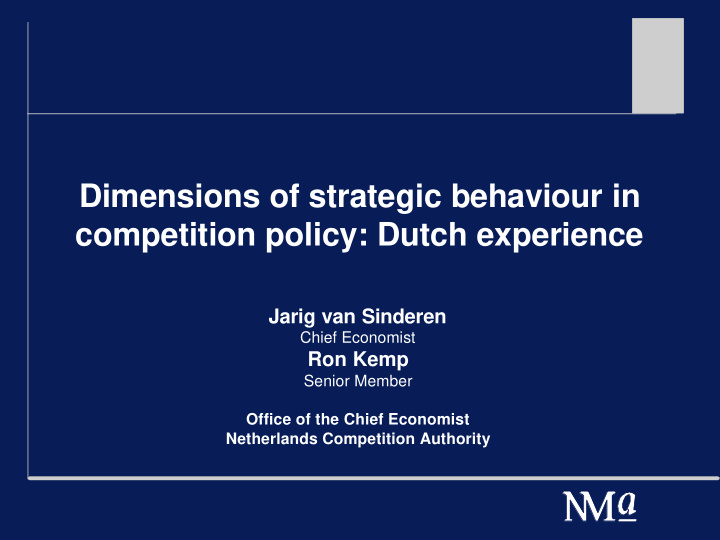



Dimensions of strategic behaviour in competition policy: Dutch experience Jarig van Sinderen Chief Economist Ron Kemp Senior Member Office of the Chief Economist Netherlands Competition Authority
Two levels of interaction between legislator and market parties Level 1: Ultimate effect of legislation: • – On outcome – The reaction of legislator might be to change the law Level 2: interactions between: • – Enforcement agency – Legislator – Judiciary – Firms – Consumers These interactions have effects on the outcome and effectiveness of legislation.
The interactions Introduction of the Competition Act. 1. The reactions after the settlement of Act. 2. Problems and reactions of economic agents 3. to type I and type II errors. Impact of judiciary on behaviour. 4. Private litigation. 5.
Introduction of Competition Act A lot of unnecessary exemptions (47%). • Only 9% granted. • So high adjustment costs. • Lesson for changes: • – Adjustment costs; – CPB: two years of adjustment. Extra argument to look into interactions of • second order.
The reactions after the settlement of Act Compliance of companies to competition law • Is the role of anticipation • Scorecard was made to look into perceived • competitive forces
2005 2006 Perceived competitive forces of Porter instutional competitive force suppliers bargaining power buyers bargaining power potential entrants sub. Entry threat internal rivalry 3,5 3 2,5 2 1,5 1 0,5 0
Statement on institutional context Statement % (totally agree 2005) % (totally agree 2006) Decisions by the 23,7 31,4 NMa strongly influence the way we do business The NMa is very 17,2 22,6 active in our market
high low “the NMa is very active in our market” 2005 insurance construct. road cons. installation bank ict r&d art paper metal 50 40 30 20 10 0
Problems and reactions of economic agents to type I and type II errors Complains: can be an instrument with the goal to • harm competitors. We found no systematic complains in certain • sectors. 2003 total of 219 complains. Investigated 69. Only 3 • cases led to some action. Maybe an action to hurt competitors. Effect was • rather limited.
Two cases Remedies case • – De Limburger and Limburgs Dagblad came in one hand. – Remedy: Structural separated. – Actual: Not the case. – Fined in first place. Later market changed and fines were withdrawn. NL.tree: KPN • – Competition on internet market in schools. – Internet for free by KPN. – Predatory pricing? First decision yes; second decision no: relevant market. So was allowed after all. – In the meantime only a few schools had switched to KPN. – So lawsuit gave advantage for a year to NL.tree.
What do we learn? Monitoring of remedies necessary. • Still defenses and market situation might change • initial decision. An action in court is an effective tool to keep • competitors from the market for a while. Effectiveness depends on strength of competitor. •
Private litigation: law suits We gave one example of reason for law suits of company- • company. Nowadays also development of private (group) law suits. • Lot of discussion: is it good development? • I have doubts. • Competition authority is the first body to deliver complaints: • – More of interest of all consumers; – More means to do investigation; – More possibility to cover a sector instead of just one company. Private law suits until now limited; should be stimulated. •
Conclusions It is important to look into interrelationships of • competitors; authorities; judiciary etc. Law changes might imply a lot of costs which might be • avoided by monitoring the interrelations. Unlawful lobby; strategic complaints difficult to prove. • Law suits more in US than in the Netherland. • Should be stimulated, but the primary Argus of • competition remains the NMa; keeper of public interest. We should avoid the “triple damage remedy”. • Involvement in merger cases is necessary; still always • be aware of the fact that remedies should be monitored.
Recommend
More recommend